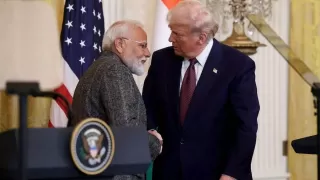India and Pakistan have a long history of tension, with military strength playing a crucial role in their strategic postures. A closer look at the top five aspects — PowerIndex, manpower, airpower, land power, and naval strength — reveals a clear picture of how the two nations stack up against each other.
1. PowerIndex and Global Ranking
When it comes to overall military power, India firmly holds the upper hand. According to the Global Firepower Index, India boasts a PowerIndex of 0.1184, ranking 4th out of 145 countries. Meanwhile, Pakistan has a PowerIndex of 0.2513, placing it at 12th globally. A lower PowerIndex signifies stronger military capabilities, and India's better ranking reflects its larger and more sophisticated defense forces.
2. Manpower
In terms of sheer manpower, India’s advantage is overwhelming. With a population of around 1.4 billion compared to Pakistan’s 252 million, India's pool of available resources is much larger. India can draw upon 662 million people fit for military service, while Pakistan’s pool is about 108 million.
Moreover, India maintains a robust active military force of 1.45 million personnel, compared to Pakistan’s 654,000. The reserve forces further tilt the balance, with India maintaining 1.15 million reserve troops against Pakistan’s 550,000. In addition, India's paramilitary strength exceeds 2.5 million personnel, vastly surpassing Pakistan’s 500,000.
3. Airpower
Air superiority is a key determinant in modern warfare, and India again leads significantly. India fields a fleet of 2,229 total aircraft, which includes 513 fighter jets and 130 dedicated attack aircraft. In comparison, Pakistan operates 1,399 aircraft, with 328 fighters and 90 attack aircraft.
India's helicopter fleet is also considerably larger, with 899 helicopters (including 80 attack helicopters) compared to Pakistan's 373 helicopters and 57 attack helicopters. The broader range of special mission aircraft and aerial refueling tankers enhances India’s operational reach and versatility in the skies.
4. Land Power
On the ground, India's dominance is evident in its larger and better-equipped land forces. India possesses 4,201 tanks, outnumbering Pakistan’s 2,627 by a wide margin. The difference in armored vehicles is even more stark, with India operating over 148,000 units, compared to Pakistan’s 17,500.
While Pakistan does have an edge in self-propelled artillery (662 units versus India’s 100), India compensates with superior numbers in towed artillery (3,975 units) and a balanced strength in rocket artillery systems. India's larger mechanized force provides it with greater mobility and firepower on the battlefield.
5. Naval Power
At sea, India’s navy overshadows Pakistan’s maritime forces both in size and capability. India maintains a fleet of 293 naval assets, including two aircraft carriers, 18 submarines, 13 destroyers, 14 frigates, and 18 corvettes. Pakistan’s navy, by contrast, operates 121 vessels with no aircraft carriers and no destroyers.
India’s superior submarine fleet and a significantly larger number of patrol vessels (135 compared to Pakistan’s 69) ensure that it maintains strong maritime dominance, particularly in the Indian Ocean Region, a critical global trade and security zone.
Conclusion:
Across all top five military dimensions — power ranking, manpower, airpower, land forces, and naval capabilities — India maintains a substantial lead over Pakistan. This advantage stems from India's larger economy, greater resource base, and consistent investment in modernizing its armed forces. While Pakistan remains a significant military power in its own right, the gap between the two nations continues to widen in India's favor.
Also Read: KKR vs PBKS Dream11 Prediction: Top Captain Or Vice-Captain For IPL 2025




























